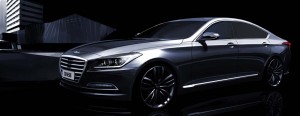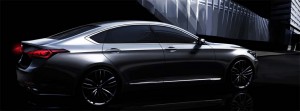
Hyundai aims to more directly take on its European rivals with the newly redesigned 2015 Genesis sedan.
Few cars have done more to transform an automaker’s image than the original Hyundai Genesis sedan which landed a slew of awards – including the coveted North American Car of the Year trophy – when it first came to market in 2008.
Now, the Korean carmaker is set to roll out Genesis 2.0, if you will, the second-generation sedan aiming to take Hyundai even more up-market with a more distinctive design, more refined features and – perhaps most critically – the promised of improved ride and handling which, the company says, was aimed to take on the benchmark BMW 5-Series.
“The evolved all-new Genesis is the product of Hyundai’s best resources and capabilities and we strongly believe it will be a game-changer in the market,” said Moon Sik Kwon, head of Hyundai Motor Group’s R&D Center, located just outside the Korean capital of Seoul.
The second-generation Hyundai Genesis, which is being shown to a small group of Korean and foreign journalists for the first time this week, is the product of a 500 billion won, or roughly $500 million, program that Kwon stressed during a dinner interview us “critical” for the Korean maker. Hyundai has significant aspirations of moving its image more upscale, a process that it began with the 2008 launch of the original Genesis and continued with the more recent introduction of the bigger Equus model.
The new Genesis – which will be sold as a 2015 model in the U.S. – is the first Hyundai to adopt the maker’s second-generation Fluidic Sculpture design language, a styling them first seen with the introduction of the current Hyundai Sonata. It is intended to give the new Genesis a more distinctive look — markedly starting with the new signature, single-frame hexagonal grille that will eventually be adopted by the rest of the maker’s line-up.
(Mercedes-Benz C-Class to get a major remake for 2015. Click Here for details.)
The renderings released today reveal a more sports coupe-style shape that is slightly longer than the original Genesis, with a more luxurious appearance highlighted by such details as the LED front accent and turn signals and the more dramatic sculpting of the rear, the overall look intended to give the 2015 Hyundai Genesis a richly muscular and well-planted appearance.
The interior is similarly improved for 2015, Hyundai adopting more up-market materials, including real leathers, woods and aluminum accents, while making ergonomic placement of switches, knobs and gauges a key element of the project.
(Consumer Reports takes a swipe at new Lexus, Infiniti models. Click Here for more.)
The maker claims to have significantly improved the stiffness of the underlying platform of the new Genesis – which went by the internal codename of DH during its development. That approach appears to have been part of a high priority push to enhance the overall ride and handling of the next-gen Genesis. Steering feel and road dynamics were the two most frequently heard criticisms of the old Hyundai Genesis, internally known as the BH model.
The revised platform should also offer improvements in crash performance — another high priority for the maker – notably including the tough new “small offset” test by the Insurance Institute for Highway Safety that has proved so troubling for many manufacturers.
While Hyundai isn’t releasing full details on the new model yet, it is expected to maintain the two engine strategy of the existing Genesis, including the big Tau V-8 and smaller Lambda V-6. The maker has confirmed that it will introduce its new HTRAC all-wheel-drive system with the launch of the 2015 Genesis. It will be paired with a new driver-selectable performance system.
(For more on the new Hyundai HTRAC all-wheel-drive system, Click Here.)
Among other new technologies Hyundai is confirming, the 2015 Genesis will be its first model to adopt a Rack-mounted Motor Driven Electric Power Steering system, and what it is calling the Advanced Traction Cornering Control which, it says, “enables greater stability in corners.”
Among safety features, the new Emergency Fastening Device system tightens seatbelts to warn of an imminent collision and to reduce the likelihood of injuries in the event of a crash.
The original Genesis sedan is generally credited with both increasing awareness and perceptions about the Hyundai brand. The BH model is nonetheless a relative niche player compared to more dominant entries like the BMW 5-Series and the Mercedes-Benz E-Class.
Hyundai hopes to boost demand for the new model – in both the U.S. and other global markets. It could also encourage the Korean carmaker to expand its luxury line-up, Dr. Kwon suggested during his dinner conversation.

